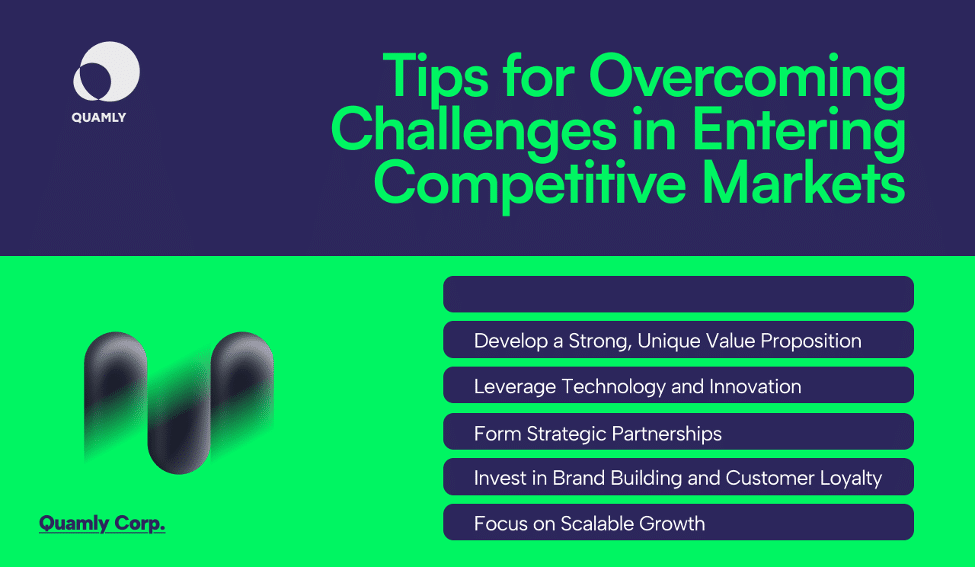Picture this: You’re at a bustling farmer’s market, surrounded by vendors selling similar products. As you stroll through the rows, one seller catches your attention—they greet you warmly, remember your preferences, and even offer a sample of something new you might like. That experience leaves a mark, making you choose their stall over the others.
Now, imagine applying that same level of insight and connection to your business strategy. Wouldn’t it give you the edge you need to stand out in a crowded market? That’s exactly where Quamly Corp comes in.
In this article, Quamly Corp reviews the challenges businesses face when entering competitive fields and shares practical tips on overcoming them. From conducting in-depth research to leveraging scalable marketing strategies, these insights will position your business for success in even the most crowded industries.
Common Challenges in Entering Competitive Markets
At times, the terrain of competitive markets can be very intimidating to the business, especially those that are new in the market or trying to venture abroad.These challenges can stem from a variety of sources—economic pressures, market saturation, and evolving customer needs. Let’s look at some of the most common challenges companies face:
1. Market Saturation and Intense Competition
One of the greatest challenges destined to be faced by companies entering the new competitive arena is called market saturation. In industries where established players were already playing, entry to the business becomes much more difficult in terms of being known to the customers. Therefore, people need to strategize on differentiation offerings, coming up with something totally new or definitely better than what already exists.
According to a 2024 study, over half of new businesses fail to survive past the five-year mark. The sheer volume of competitors can make it difficult to gain traction, especially in markets where brand loyalty is strong.
2. Grasping and Targeting the Right Customer Segment
Without a doubt, the success of a business depends on the understanding of its customers. However, that cannot be gained without understanding everything about them-their tastes, behaviors, and ultimately, their needs. Misunderstanding the target market can lead to poor customer acquisition strategies, ineffective messaging, and low customer retention.
3. Brand Recognition and Trust
Building brand recognition in a competitive market can be a slow and expensive process. When competing against established companies, new entrants often face the challenge of earning consumer trust. Customers tend to prefer brands they are familiar with, and this can make it difficult for new businesses to gain credibility quickly.
For example, Quamly Corp recognized early on that trust and credibility are key to breaking into competitive markets. By offering consistent value and maintaining a strong focus on customer experience, Quamly was able to overcome this hurdle.
4. Resource Limitations and Scalability
Competing against larger, more established companies often means that resources—whether in terms of capital, human resources, or infrastructure—are limited. Many smaller companies struggle to scale effectively in competitive environments due to these constraints. Not to mention, if effective resource allocation is not done, it might lead to either operational inefficiencies or missed opportunities because of significant rapid growth.
Quamly Corp’s Suggestions On Overcoming These Obstacles
Indeed, the challenge is significant but not impossible. Quamly Corp offers major strategies for guiding all businesses through the hurdles effectively and placing them in winning positions in competitive markets.

1. Carry Out Thorough Market Research
One of such important strategies in overcoming competitive market challenges is an all-encompassing market research. Understanding the competitive landscape and identifying their needs is as important as knowing their experience in the industry.
Quamly Corp started to become successful in competitive markets through rigorous research about their target customers and competitors. Market research is not only about understanding the market, but also identifying emerging trends that can give a company a competitive edge. By continuously monitoring customer behavior and competitor activities, businesses can stay ahead of the curve and anticipate market shifts.
2. Develop a Strong, Unique Value Proposition
A vital point when entering a competitive industry is turning out an extravagant joint value proposition, clearly separating your offering from others. The UVP must specifically focus on addressing the benefits achievable by a customer from the product or service, as well as the pain points of the customer and how that particular competitor cannot provide solutions to those points.
To create a compelling UVP, businesses must ask themselves:
- What makes us different from our competitors?
- What specific problems do we solve for our customers?
- How can we deliver that solution better than anyone else in the sector?
3. Leverage Technology and Innovation
Innovation is a powerful tool for overcoming the challenges of competitive sectors. By adopting new technologies or improving existing solutions, businesses can deliver better value to their customers, improve operational efficiency, and gain a technological edge over competitors.
Quamly Corp recommends using the latest technologies, from artificial intelligence (AI) to data analytics, to enhance your offerings. By integrating innovative technologies into their products, you can address gaps in customer needs that competitors hadn’t yet tapped into.
Technology and innovation also allow businesses to scale quickly and manage resources more efficiently. Whether through automation, data-driven decision-making, or cloud computing, businesses can harness these tools to navigate challenges more effectively.
4. Form Strategic Partnerships
Building partnerships with other businesses, organizations, or influencers can help strengthen a company’s position in a competitive industry. Strategic partnerships can provide access to new customers, enhance credibility, and boost market presence.
For Quamly Corp, forming strategic alliances with complementary brands and industry leaders has been essential to gaining industry share. These partnerships provided a platform for co-marketing, shared resources, and mutual growth.
When entering a competitive market, businesses should consider potential partners that can help amplify their reach and fill gaps in their offerings. Whether it’s a partnership with a technology provider or an influencer in the industry, these relationships can help businesses gain a foothold.
5. Invest in Brand Building and Customer Loyalty
In competitive sectors, brand recognition and customer trust are crucial. Building a strong, recognizable brand that resonates with customers takes time and consistent effort. Businesses need to invest in brand-building activities, including marketing, customer service, and relationship management.
Quamly Corp focused heavily on building a strong brand identity, one that emphasizes reliability, innovation, and customer care. By consistently delivering value and engaging with customers, the company was able to create a loyal customer base and gradually build recognition.
Investing in loyalty programs, personalized marketing, and ongoing customer engagement can help businesses retain customers, turning them into brand advocates who will refer others to your company.
6. Focus on Scalable Growth
Finally, businesses entering competitive sectors must focus on scalable growth. As companies grow, they must ensure that their infrastructure, operations, and teams are capable of handling increased demand. Strategic planning and careful management of resources are essential for avoiding growing pains.
We suggest developing a robust scaling strategy that focuses on optimizing operational efficiency, hiring the right talent, and implementing scalable technologies. By automating key processes and relying on a flexible infrastructure, the company was able to grow without compromising on quality or customer experience.
Final Notes
Entering competitive industries requires a strategic approach to overcome the challenges that come with it. Quamly Corp notes that it’s possible to break into competitive markets and thrive. From using innovative solutions to forming strategic partnerships, businesses can create a path to growth and scalability. By implementing these strategies, companies can stand out in even the most saturated fields and build a loyal customer base.
